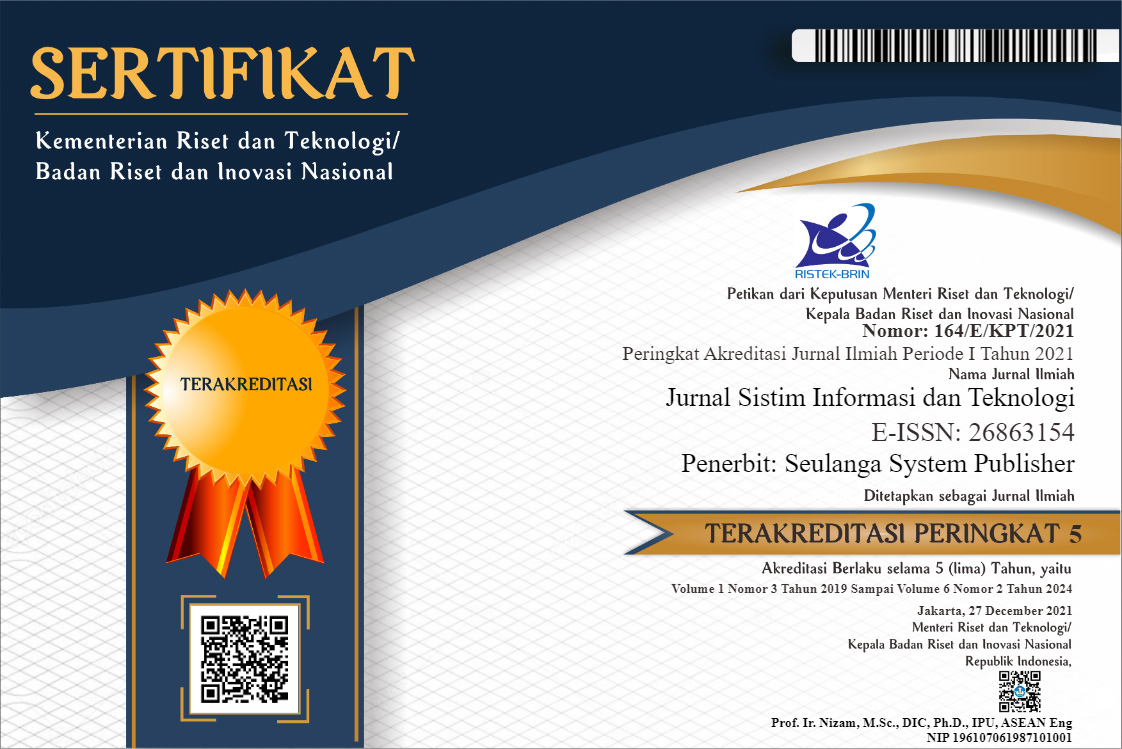Metode Fuzzy untuk Mengidentifikasi Kepribadian Siswa
DOI:
https://doi.org/10.37034/jsisfotek.v4i3.165Keywords:
Personality, Identification, Fuzzy Tsukamoto, Expert System, PhsychologyAbstract
Personality identification is one of the important things to know yourself and others. This identification is done based on the personality traits possessed by a person based on Kant's personality theory. Not a few teachers who do not understand the student's personality, in the teaching and learning process some teachers who do not understand the student's personality, a teacher will find it difficult to convey learning materials that will attract students' interest which has an impact on the knowledge transfer process being hampered. Then the Fuzzy Tsukamoto method is used to identify the student's personality. The purpose of this research is to help teachers in classifying and recognizing students' personalities so that it is easier to determine treatment in developing their talents and interests. The system input is obtained from personality traits that are suitable for students. The knowledge base was obtained from a Child Clinical Psychologist and was built with the qadidah (IF-THEN). The output of the Fuzzy calculation is that students have a Sanguine, Choleric, Melancholic or Phlegmatic personality. The results of testing this method by doing calculations and testing the system, it is obtained that personality outputs are in accordance with the personality characteristics of students and are running well. So it can be recommended to help teachers in determining the treatment of students.
References
Chairunnisa, C., Radityo, H., Wicaksono, H. R., & Ayyasy, S. T. (2021). Penerapan Algoritma pada Artificial Intelligence sebagai Upaya Menangani Penyebaran Hoax. Cakrawala, 15(2), 174–187. https://doi.org/10.32781/cakrawala.v15i2.316
Pakpahan, R. (2021). Analisa Pengaruh Implementasi Artificial Intelligence Dalam Kehidupan Manusia. Journal of Information System, Informatics and Computing, 5(2), 506–513. https://doi.org/10.52362/jisicom.v5i2.616
Wandira, R., & Naam, J. (2020). Implementasi Metode Forward Chaining dalam Mengidentifikasi Kepribadian Siswa. Jurnal CoSciTech (Computer Science and Information Technology), 1(2), 84–92. https://doi.org/10.37859/coscitech.v1i2.2236
Sinaga, M. D., Sembiring, N. S. B., Sianturi, C. J. M., & Sianturi, C. J. M. (2020). Penerapan Metode Fuzzy Tsukamoto Untuk Mendiagnosa Penyakit Leptospirosis. CSRID (Computer Science Research and Its Development Journal), 12(2), 98–106. https://doi.org/10.22303/csrid.12.2.2020.98-106
Wijaya, J. D., & Yunus, Y. (2021). Sistem Pakar untuk Mengukur Tingkat Akurasi Dalam Mengidentifikasi Kepribadian Menggunaakan Metode Forward Chaining. Jurnal Informasi Dan Teknologi, 3(1), 42–46. https://doi.org/10.37034/jidt.v3i1.99
Pardede, E. O., Situmorang, A., Yohana, M., & Silalahi, A. P. (2021). Analisa Penentuan Jurusan Sesuai Kepribadian Untuk Siswa SMA Kelas 3 Menurut Hippocrates Dengan Menggunakan Metode Profile Matching Berbasis Android Di SMA Negeri 1 Habinsaran. 1(1), 16–21. https://doi.org/10.46880/methotika.v1i1.4
Hardianto, R. (2018). Sistem Pakar Penetuan Tipe Kepribadian Sisea Sekolah Dasar Menggunakan Metode Case Based Reasoning. Intecoms: Journal of Information Technology and Computer Science, 1(2), 240–250. https://doi.org/10.31539/intecoms.v1i2.298
Putri, N. A. (2018). Sistem Pakar untuk Mengidentifikasi Kepribadian Siswa Menggunakan Metode Certainty Factor Dalam Mendukung Pendekatan Guru. Intecoms: Journal of Information Technology and Computer Science, 1(1), 78–90. https://doi.org/10.31539/intecoms.v1i1.164
Maiyendra, N. A. (2018). Perancangan Sistem Pakar Mendiagnosa Penyakit Kulit Pada Anak Dengan Menggunakan Metode Backward Chaining. Jursima, 6(2), 6. https://doi.org/10.47024/js.v6i2.120
Julita, R. (2018). Sistem Pakar Pemilihan Menu Makanan Berdasarkan Penyakit Dan Golongan Darah. Pseudocode, 5(1), 56–68. https://doi.org/10.33369/pseudocode.5.1.56-67
Lesmana, L. S. (2018). Sistem Pakar Backward Chaining Untuk Pemilihan Alat Kontrasepsi Yang Cocok Berbasis Android. Edik Informatika, 4(1), 10–22. https://doi.org/10.22202/ei.2017.v4i1.2533
Ragestu, F. D., & Sibarani, A. J. P. (2020). Penerapan Metode Fuzzy Tsukamoto Dalam Pemilihan Siswa Teladan di Sekolah. Teknika, 9(1), 9–15. https://doi.org/10.34148/teknika.v9i1.251
Mandala, E. P. W., & Putri, D. E. (2021). Penerapan Fuzzy Tsukamoto Untuk Menentukan Jumlah Produksi Rakik. JURTEKSI (Jurnal Teknologi Dan Sistem Informasi), 8(1), 1–10. https://doi.org/10.33330/jurteksi.v8i1.665
Anggraeni, I., & Yanti, Y. (2020). Sistem Pemantauan Pertumbuhan Batita Menggunakan Metode Fuzzy Tsukamoto. Komputasi: Jurnal Ilmiah Ilmu Komputer Dan Matematika, 17(1), 346–353. https://doi.org/10.33751/komputasi.v17i1.1749
Muhandhis, I., Ritonga, A. S., & Murdani, M. H. (2021). Implementasi Metode Inferensi Fuzzy Tsukamoto Untuk Memprediksi Curah Hujan Dasarian Di Sumenep. Jurnal Ilmiah Edutic : Pendidikan Dan Informatika, 8(1), 1–10. https://doi.org/10.21107/edutic.v8i1.8907
Uljanah, I. I., & Uyun, S. (2021). Multi-Layer Inference Fuzzy Tsukamoto Determining Land Suitability Class of Cocoa Plants. Jurnal Teknik Informatika, 14(1), 1–10. https://doi.org/10.15408/jti.v14i1.13616
Ezar, M., Rivan, A., Octavia, A., Wijaya, D. I., Rajawali, J., & 14 Palembang, N. (2021). Desain Model Fuzzy-Tsukamoto Untuk Penentuan Kualitas Buah Pepaya California (Carica Papaya L.) Berdasarkan Bentuk Fisik. Saintekom, 11(1), 11–21. https://doi.org/10.33020/saintekom.v11i1.155
Numan, N., Kusumadewi, S., & Muzayyanah, N. (2020). Sistem Inferensi Fuzzy Untuk Membantu Diagnosis Penyakit Pneumonia Anak. IT Journal Research and Development, 5(1), 53–62. https://doi.org/10.25299/itjrd.2020.vol5(1).5088
Kotimah, Q., Firdaus Mahmudy, W., & Nur Wijayaningrum, V. (2017). Optimization of fuzzy Tsukamoto membership function using genetic algorithm to determine the river water. International Journal of Electrical and Computer Engineering, 7(5), 2838–2846. https://doi.org/10.11591/ijece.v7i5.pp2838-2846
Ranggadara, I. (2019). Fuzzy Tsukamoto and ITIL for improvement strategy on incident ticket services. International Journal of Innovative Technology and Exploring Engineering, 8(10), 897–903. https://doi.org/10.35940/ijitee.J9063.0881019
Rohmani, A., & Untung, D. (2020). Prototype Sistem Pendiagnosa Penyakit dan Hama Tanaman Bawang Merah di Kabupaten Brebes dengan Metode Fuzzy Tsukamoto. JOINS (Journal of Information System), 5(1), 102–114. https://doi.org/10.33633/joins.v5i1.3511
Julianto, D. P. A., Andryana, S., & Gunaryati, A. (2021). Rancang Bangun Sistem Informasi Penggajian Karyawan Menggunakan Metode Fuzzy Tsukamoto. JATISI (Jurnal Teknik Informatika Dan Sistem Informasi), 8(4), 1710–1722. https://doi.org/10.35957/jatisi.v8i4.1097
Kurniati, N. I., Akbar, R. R. El, & Wijaksono, P. (2019). Penerapan Metode Fuzzy Tsukamoto Pada Sistem Pakar untuk Mendiagnosa Autisme Pada Anak. Innovation in Research of Informatics (INNOVATICS), 1(1), 21–27. https://doi.org/10.37058/innovatics.v1i1.676
Downloads
Published
How to Cite
Issue
Section
License
Copyright (c) 2022 Jurnal Sistim Informasi dan Teknologi

This work is licensed under a Creative Commons Attribution 4.0 International License.









